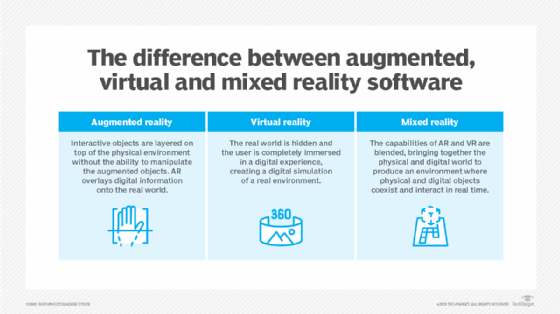What is VR locomotion (virtual reality locomotion)?
VR locomotion refers to the techniques and technologies that allow users to move within a virtual reality (VR) environment. Unlike real-world movement, where locomotion is intuitive and physical, moving through a digital space requires translation of user inputs -- either physical or simulated -- into virtual movement.
As immersive VR continues to evolve, locomotion remains a key challenge in enhancing presence, reducing VR sickness, and enabling more natural user interactions across consumer, enterprise and simulation applications.
Types of VR locomotion methods
There are several primary methods of locomotion in VR, each with its own advantages, challenges and ideal use cases.
Artificial locomotion
Artificial locomotion refers to navigation controlled by hand-held devices like VR controllers or joysticks. Users might push forward on a thumbstick to "walk" or "run" in the virtual space. While widely used, this technique can cause VR motion sickness, because the user's visual senses move while the vestibular (inner ear) system does not.
To help mitigate discomfort, many VR systems offer alternative forms of movement, such as teleportation and redirected walking.
Teleportation
Teleportation is a common VR locomotion method where users point to a desired location and press a button to "jump" there instantly. This reduces motion sickness because there is no artificial visual flow simulating walking or running. It's often used in room-scale VR when space limits user movement.
Teleportation continues to be a default in many VR games and enterprise applications due to its simplicity and accessibility.
Room-scale movement
In room-scale VR, users physically walk around within a limited tracked area, which matches their real-world movement to virtual space. This method offers natural movement but is constrained by available physical space.
Room-scale VR remains a foundational feature for high-end VR platforms such as the Meta Quest 3, Valve Index and HTC Vive XR Elite, particularly in training simulations and fitness experiences.
Omnidirectional treadmills
Omnidirectional treadmills allow users to walk or run in any direction while staying in a fixed space. The treadmill surface adjusts dynamically to the user's direction of movement, creating the illusion of walking freely in a large virtual world.
Today, companies like Virtuix and Kat VR have released more compact and consumer-friendly versions of omnidirectional treadmills, making them increasingly popular in VR arcades, training simulators and home gaming setups.
Redirected walking
Redirected walking is a technique that subtly guides users through physical space by slightly altering the virtual environment, so the user unknowingly walks in circles or turns. This allows VR experiences to fit large digital spaces into small physical ones.
An example includes Walkabout locomotion from Tekton Games, where users "freeze" the environment at a boundary, turn around, and continue exploring from the same position, seamlessly expanding the virtual world.

The benefit of VR locomotion
Unobtrusive and natural-feeling locomotion is essential for immersion in VR. Whether for gaming, remote collaboration, physical rehabilitation or military training, users need to move freely and comfortably within virtual environments. Poor locomotion can break immersion, cause discomfort and limit the effectiveness of VR applications.
The future of VR locomotion will likely rely on a hybrid model, combining physical movement, intelligent software and specialized hardware to provide fluid, adaptive movement tailored to user needs and environments. Here are some recent trends in VR locomotion.
New trends in VR locomotion
In recent years, several advances have begun pushing VR locomotion further, for example:
- Foot tracking and haptics. Devices like Sony's Mocopi and SlimeVR enable real-time tracking of foot and leg movement (or haptics), which allows for more natural walking and crouching.
- AI-assisted pathing. Some VR platforms now use AI, such as machine learning, to predict user intent and smooth out motion transitions to reduce nausea.
- Mixed reality integration. Headsets like the Apple Vision Pro and Meta Quest 3 blend real-world elements into VR locomotion to reduce disorientation when transitioning between virtual and physical spaces.
- Wearable locomotion suits. Lightweight exosuits and motion belts are being developed to simulate leg resistance and replicate walking sensations without requiring a large space.
As tools evolve, achieving immersive and intuitive VR locomotion is increasingly attainable.
Whether it's augmented reality, virtual reality or mixed reality, each immersive technology has the potential to enhance digital experiences for individuals. Examine how thesethree technologies differ from one another. Also, learn about mixed reality, which combines a fully immersive computer-generated virtual reality experience with elements of augmented reality, integrating digital elements into the physical world, and check out the top uses for VR in learning and development.